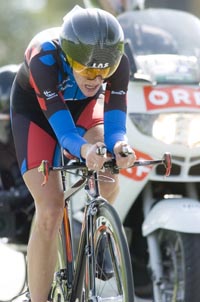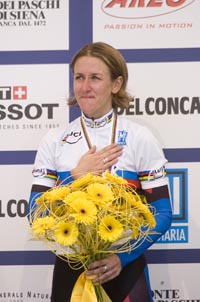Ok, let’s cut to the chase here. Most articles about wind tunnel visits are dry humps. They get you close to the promised land, show you sexy, arousing pictures, but stop short of making YOU faster. They never tell you anything you can use; they just go on about how cool the tunnel is, how fabulous the author is for having been there, and how inadequate you are in comparison. This isn’t that surprising. Wind tunnel testing is expensive, and no one’s willing to just give away their information, not after they’ve paid through the nose to get it.
I’ll try not to write that article here.
Smilie and Mike have enough confidence in their abilities as bike fitters that they know they won’t make themselves obsolete by giving away information. As for background on the tunnel, the San Diego Low Speed Wind Tunnel has received so much press I don’t think I can tell you anything that you don’t already know.
If you’ve read part 1 of this story, you know that Smilie and Mike took Kristin Armstrong and Bernard van Ulden to the LSWT, in an effort to help them win World’s and Nationals respectively. While Bernard had an off day and finished 5th, Kristin had a great ride and brought home the rainbow jersey. Most tellingly, Kristin put more time into last year’s winner Karin Thurig on the descents than the climbs, even though Kristin thinks she climbs better and descends worse than Thurig. Clearly the tunnel visit helped.
Now, I can’t give you the actual data from the visit, because some clever person can take CdA numbers and work out Kristin and Bernard’s power numbers. But I can give you numbers in terms of % improvement.
 |
1. Get those elbows narrow. Narrowing the elbows doesn’t necessarily reduce your frontal area, but it does reduce your Cd. We don’t know if it accomplishes this by blocking the pocket under your chin, or smoothing the lines of shoulders. Kristin got a 6% improvement in her Cd by narrowing her elbows 3.5 cm. Bernard didn’t get as much of a boost from this, but he still got a 2% improvement.
2. Drop your head and tuck your shoulders. This reduces your frontal area and saves you big time. Bernard and Kristin both got a 6% improvement from this move. Kristin found this position pretty uncomfortable, but given the data, she was eager to work on being able to hold it. You can actually see it in practice from her photos at World’s. Kraig Willett said that you can hear the difference between the two positions. Ducking your head gets it out of the fast air into the pocket in front of your torso.
3. Stretch out. Generally speaking, more extended is better. Kristin had a tendency to choke up on the extensions for more power, curling her back. But after a few tweaks by Craig and Mike, she naturally moved her hands up to the shifters. She ended up more stretched out and flatter, a 5% improvement. Bernard came up against UCI regulations, and couldn’t stretch out any more. His position was already extremely aggressive, so much so that Craig and Mike raised him a touch to open up his hips.
You have to be careful with this, though. You’re looking to extend your back, not your arms. A lot of people get so stretched they can barely support their body weight with their arms. A well balanced position should require no muscular effort to hold.

Before and after of Kristin.
4. TT position is not set in stone. Both Kristin and Bernard tweak their setups to suit the course. Both their big races have a good bit of climbing, so they opted for slightly less aggressive positions. Oval wanted to make Kristin a custom set of their $2500 JetStream aerobars for World’s, but since the handgrips are very low and forward, she chose to stay with her A900’s so she could climb better. Conversely, they’d go lower for flatter races. Furthermore, you can switch positions during a race. The painful head duck can be saved for fast or headwind sections, where you’d get the most time savings in exchange for your discomfort.
5. Floyd: the jury’s still out. We tried the Floyd on Kristin, and our findings on the track were verified, shockingly enough. Once we got Kristin nice and low, raising her hands had no effect on her drag numbers. And since Kristin can get low without doing the Floyd, there was no reason to keep her hands up (it’s harder to handle the bike with the Floyd).
So why does Floyd do the Floyd? My guess is that by putting the extensions at an angle, Floyd has found a loophole in the UCI regulations. Floyd needs to ride a very steep seat tube angle to open up his hip angle and relieve pressure on his bum hip joint. By setting his forearms at an angle, he effectively moves his elbows forward, moving his whole torso forward without increasing his overall extension, thereby staying legal. We could’ve gotten Bernard lower with the Floyd, but he didn’t want to experiment with a position that might be outlawed at a future date.
6. The engine’s still key. None of this matters if you can’t pump out the watts. One subtle change made Kristin’s quads burn like crazy. A slight tweak to her saddle height fixed that. It’s all well and good to try to get aero, but it won’t help at all if you’re not pumping out your max power. Placing the saddle in the right place is the first step to any bike fit.
Finally, we have some words from the champ herself. I hope to get a more thorough interview with Kristin soon, but for some reason her time seems to be in high demand these days. She was nice enough to answer some quick questions, though:
NYVC How was the position? Comfortable/painful? Looked like you were doing the head duck in the photos.
KA When I am going full throttle no position is comfortable. I have always told myself that if I am comfortable on my TT bike then I am definitely not aero enough. Don’t get me wrong, you need to be somewhat comfortable to produce power on a TT bike but there are certain pieces of the position that a rider just has to accept. The head duck was definitely a huge piece of becoming more aero while on the road, as we saw in the wind tunnel. It took a lot of focus to keep my head in this position while going so hard. I learned from Craig’s team how important it was to decreasing drag. This is something I thought about during the World Championships. It also helped having my coach driving behind me reminding me to keep my head down.
NYVC Did the position change alter the way you pedal (more stretched, less pulling on the bars…)?
KA Prior to becoming a professional cyclist I was racing as a triathlete. If you saw pictures of me five years ago from now you would be absolutely amazed. Becoming more aero over the years didn’t come overnight. It has taken a lot of work, especially in the area of flexibility. Stretching and core work have been a critical part to becoming more aero. This has really helped me optimize my aero position over the years.
It was clear after my testing at the wind tunnel that it was critical for me to stretch out more on my bars vs. choking up on them. This helped create less drag as well as helped create less tension in my shoulders.
NYVC How much time were you able to get in on the TT bike after the wind tunnel visit?
KA I visited the wind tunnel on August 11th, 6 weeks prior to the World Championships. Being in the wind tunnel was something that I have dreamed about doing for the last few years. Thanks to Craig Upton he made it happen.
In 2004, I went to the velodrome in Germany with Uli from SRM. He tested my position using my powermeter using time, power, and speed. This was a great beginning to fine tuning my position. One step closer to the wind tunnel.
 |
Prior to the wind tunnel testing I was a bit nervous. It was something I had dreamed of doing but also had a sense of insecurity because I had been winning races. I thought, “Why change a good thing?†I went ahead and took the once in a lifetime opportunity. I attribute my gold medal to this fine tuning.
Before the World Championships I was able to test my new position twice on a local 10 mile course. I definitely didn’t feel as natural on my bike but I saw improvements right away relative to both my times and the competition. I also was able to ride this position two more times in Europe as part of a stage race. After a few great results I felt confident on the big day.
NYVC I read somewhere you said that you thought Thurig was a better descender, so you had to make up time on the climb. But you got more time on her (proportionally) on the descents instead of the climbs. Was this surprisng?
KA Yes, this was surprising. Karin’s power is amazing and I find that her strength as a time trialist is typically on rolling terrain as well as flat courses. She can produce an amazing amount of power. I assumed that the second half of the course would be a great place for her to gain time on her competitors. This in turn made the first half of the course, which included a lot of climbing and technical descending and cornering, a critical part of my race plan. The head duck really came into play on the second half of this course. I was stretching out and ducking as much as I possibly could.
World’s photos courtesy Casey Gibson.

Didnt know the UCI were also in the biz of TT position regulation on how stretched out and low one can be. Why is this regulated?
Big NYC pat on the back to KA and the Lipton program. I hope you ladies crush the Geelong!
aaaaaand…congrats to Navigator success on the track, as Evil pointed out here earlier. That squad seriously needs some Pro-tour love – quick. This may not matter in the next season or two but they seem to be much more dynamic than – Barloworld?
Nice work Mike and Craig – you guys are doing cool stuff for a squad that seems like they’re on the brink of tradin pulls with the big dogs @ the Grand Tours. Every other day I check cyclingnews there’s navigator press flying around.
lastbutnotleast – fine article NYVC.